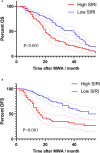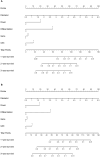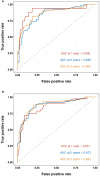Preoperative systemic immune-inflammation index-based nomogram for lung carcinoma following microwave ablation -a real world single center study
- PMID: 38571504
- PMCID: PMC10987766
- DOI: 10.3389/fonc.2024.1305262
Preoperative systemic immune-inflammation index-based nomogram for lung carcinoma following microwave ablation -a real world single center study
Abstract
Background: The preoperative inflammatory condition significantly influences the prognosis of malignancies. We aimed to investigate the potential significance of preoperative inflammatory biomarkers in forecasting the long-term results of lung carcinoma after microwave ablation (MWA).
Method: This study included patients who received MWA treatment for lung carcinoma from Jan. 2012 to Dec. 2020. We collected demographic, clinical, laboratory, and outcome information. To assess the predictive capacity of inflammatory biomarkers, we utilized the area under the receiver operating characteristic curve (AUC-ROC) and assessed the predictive potential of inflammatory biomarkers in forecasting outcomes through both univariate and multivariate Cox proportional hazard analyses.
Results: A total of 354 individuals underwent MWA treatment, of which 265 cases were included in this study, whose average age was 69.1 ± 9.7 years. The AUC values for the Systemic Inflammatory Response Index (SIRI) to overall survival (OS) and disease-free survival (DFS) were 0.796 and 0.716, respectively. The Cox proportional hazards model demonstrated a significant independent association between a high SIRI and a decreased overall survival (hazard ratio [HR]=2.583, P<0.001). Furthermore, a high SIRI independently correlated with a lower DFS (HR=2.391, P<0.001). We developed nomograms utilizing various independent factors to forecast the extended prognosis of patients. These nomograms exhibited AUC of 0.900, 0.849, and 0.862 for predicting 1-year, 3-year, and 5-year OS, respectively. Additionally, the AUC values for predicting 1-year, 3-year, and 5-year DFS were 0.851, 0.873, and 0.883, respectively.
Conclusion: SIRI has shown promise as a valuable long-term prognostic indicator for forecasting the outcomes of lung carcinoma patients following MWA.
Keywords: biomarkers; lung carcinoma; microwave ablation; prognosis; systemic inflammatory response index.
Copyright © 2024 Wang, Cui, Zhao, Gao, Ji, Liu, Miao, Fu and Hu.
Conflict of interest statement
The authors declare that the research was conducted in the absence of any commercial or financial relationships that could be construed as a potential conflict of interest.
Figures




Similar articles
-
Preoperative systemic inflammatory response index predicts the prognosis of patients with hepatocellular carcinoma after liver transplantation.Front Immunol. 2023 Mar 27;14:1118053. doi: 10.3389/fimmu.2023.1118053. eCollection 2023. Front Immunol. 2023. PMID: 37051235 Free PMC article.
-
[The prognostic value of preoperative peripheral blood inflammatory biomarkers for intrahepatic cholangiocarcinoma after radical resection].Zhonghua Zhong Liu Za Zhi. 2022 Nov 23;44(11):1194-1201. doi: 10.3760/cma.j.cn112152-20210324-00265. Zhonghua Zhong Liu Za Zhi. 2022. PMID: 36380668 Chinese.
-
Prognostic Value of the Systemic Inflammatory Response Index in Patients Undergoing Radical Cystectomy for Bladder Cancer: A Population-Based Study.Front Oncol. 2021 Aug 16;11:722151. doi: 10.3389/fonc.2021.722151. eCollection 2021. Front Oncol. 2021. PMID: 34485155 Free PMC article.
-
Prognostic value of systemic inflammation response index in hepatoblastoma patients receiving preoperative neoadjuvant chemotherapy.Front Oncol. 2023 Oct 13;13:1276175. doi: 10.3389/fonc.2023.1276175. eCollection 2023. Front Oncol. 2023. PMID: 37901310 Free PMC article.
-
Correlation analysis of hemoglobin, albumin, lymphocyte, platelet score and platelet to albumin ratio and prognosis in patients with lung adenosquamous carcinoma.Front Oncol. 2023 Sep 7;13:1166802. doi: 10.3389/fonc.2023.1166802. eCollection 2023. Front Oncol. 2023. PMID: 37746281 Free PMC article. Review.
Cited by
-
Sarcopenia predicts immune-related adverse events due to anti-PD-1/PD-L1 therapy in patients with advanced lung cancer.Front Oncol. 2024 Sep 23;14:1450020. doi: 10.3389/fonc.2024.1450020. eCollection 2024. Front Oncol. 2024. PMID: 39376979 Free PMC article.
-
Prognostic indicators and nomograms for postoperative survival among younger patients with non-small cell lung cancer.J Thorac Dis. 2025 Apr 30;17(4):2365-2376. doi: 10.21037/jtd-2025-348. Epub 2025 Apr 28. J Thorac Dis. 2025. PMID: 40400926 Free PMC article.
-
Predictive value of the monocyte-to-high-density lipoprotein ratio in the prognosis of non-small cell lung cancer patients after surgery.Transl Lung Cancer Res. 2025 Apr 30;14(4):1340-1350. doi: 10.21037/tlcr-2025-171. Epub 2025 Apr 27. Transl Lung Cancer Res. 2025. PMID: 40386725 Free PMC article.
-
Novel non-curable resection prediction model for early colorectal cancer following endoscopic submucosal dissection based on inflammatory immune index.Front Med (Lausanne). 2025 May 8;12:1489842. doi: 10.3389/fmed.2025.1489842. eCollection 2025. Front Med (Lausanne). 2025. PMID: 40406409 Free PMC article.
-
Exploring the impact of variable power outputs on the efficacy and safety during microwave ablation for lung carcinoma: a real-world study.J Thorac Dis. 2024 Aug 31;16(8):5031-5041. doi: 10.21037/jtd-24-557. Epub 2024 Aug 28. J Thorac Dis. 2024. PMID: 39268093 Free PMC article.
References
-
- Huang G, Yang X, Li W, Wang J, Han X, Wei Z, et al. . A feasibility and safety study of computed tomography-guided percutaneous microwave ablation: a novel therapy for multiple synchronous ground-glass opacities of the lung. Int J Hyperthermia. (2020) 37(1):414–22. - PubMed
LinkOut - more resources
Full Text Sources
Research Materials

